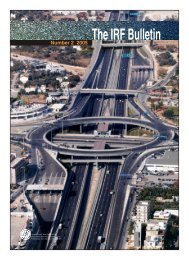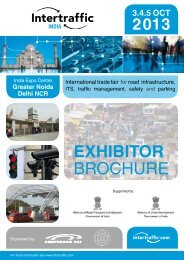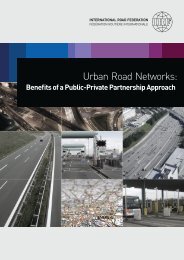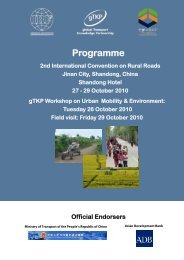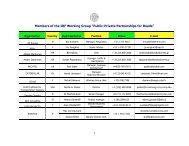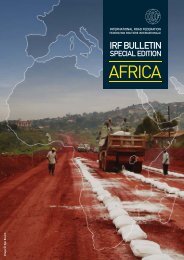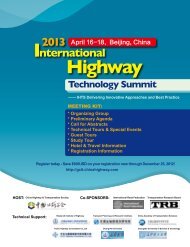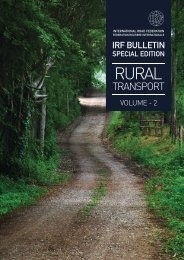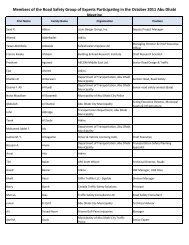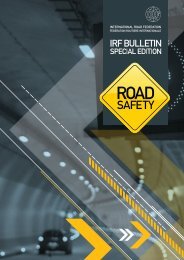Download - IRF | International Road Federation
Download - IRF | International Road Federation
Download - IRF | International Road Federation
Create successful ePaper yourself
Turn your PDF publications into a flip-book with our unique Google optimized e-Paper software.
ROAD SAFETY<br />
Truck conspicuity - contour marking from Turkey<br />
Effective signs and road markings provide a low cost<br />
measure with immediate return on accident reduction.<br />
The use of fluorescent signs have shown to be specifically<br />
effective regarding black spot eradication, construction<br />
work zones and school safety zones.<br />
Protect the vulnerable road users: Asia counts many<br />
casualties amongst motorcycle drivers, as the heavier<br />
goods vehicles are increasing exponentially and<br />
infrastructure can not separate these road users. Brazil,<br />
coping with the same problem, has issued regulations<br />
aiming to protect these vulnerable road users. Both<br />
helmet and the rear of the motorcycle need to carry<br />
reflective material. The addition of fluorescent colours<br />
would increase daylight visibility.<br />
Truck Conspicuity: crash investigations generally show<br />
that nearly 5% of severe truck accidents can be traced<br />
back to poor conspicuity of the truck or its trailer at night.<br />
These accidents can be characterised by the fact that car<br />
drivers often fail to recognise trucks or truck<br />
combinations driving ahead of them. In most cases trucks<br />
are in slow motion, are entering the road or are turning<br />
off the road. Trucks can be rendered much more<br />
conspicuous by marking their sides and rear using retro<br />
reflective marking tape. The truck is therefore made<br />
visible to other road users thereby reducing accidents,<br />
specifically rear and side impacts into large vehicles.<br />
UNECE Regulation 104 sets out an international<br />
specification for retro-reflective marking tape. Another<br />
UNECE regulation (R48) sets out requirements for the<br />
installation of lighting and light signaling devices on<br />
vehicles. This regulation currently mandates the<br />
installation of conspicuity markings for new type<br />
approvals and will later expand to all new registrations.<br />
NHTSA report (2001) concluded that related<br />
accidents have reduced by about 29%-with 44% less<br />
fatalities-since implementation of these regulations<br />
on large trucks in the 80's. The Abu Dhabi authorities<br />
specified the need for fluorescent colours, with will<br />
provide the conspicuity effect during daylight.<br />
Trains and rail road crossings: a train traveling at 80<br />
km/hr needs 2 km to stop. One is 30 times more likely to<br />
die in a crash with a train than in a crash with another<br />
motor vehicle. Derailment can result and, if a freight train<br />
is involved, there is a possibility that hazardous material<br />
on the train could endanger an entire community. Beside<br />
the human tragedy, the economic cost could be extremely<br />
high. Several countries consider rail road crossings as<br />
black spots and have considered special, often<br />
fluorescent, signs to announce these intersections. Other<br />
countries like South Africa have implemented special<br />
regulations to make trains and wagons more visible.<br />
Fluorescent retro-reflective signing to better inform drivers<br />
of road works, in daylight conditions - yellow sign on left<br />
is non-fluorescent.<br />
Many countries, such as UAE (Abu Dhabi), South Africa,<br />
Italy, Romania and the US, already mandate these<br />
markings for all trucks and trailers on the road. The US<br />
<strong>IRF</strong> BULLETIN SPECIAL EDITION : ASIA & OCEANIA<br />
24



